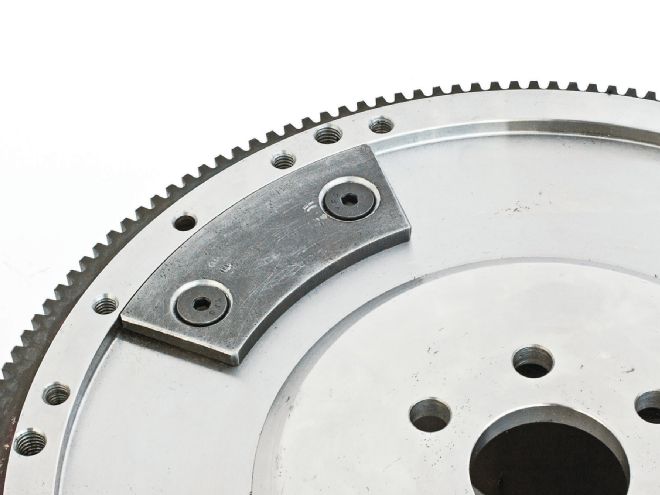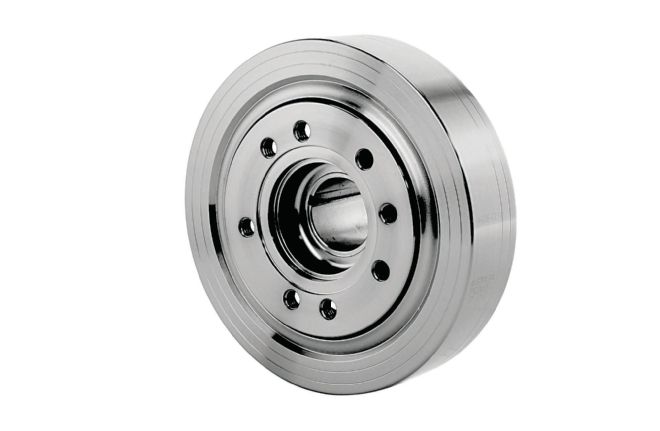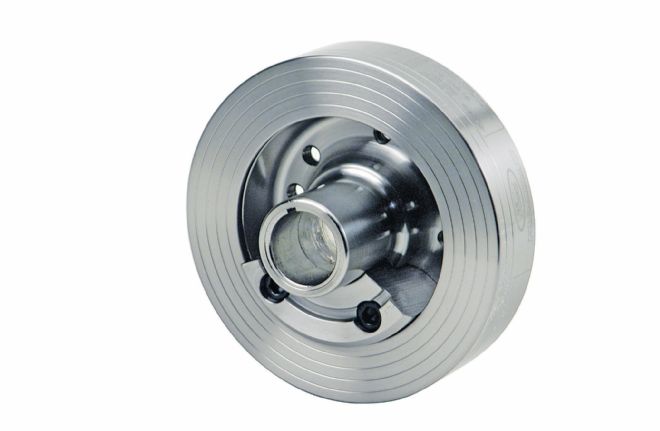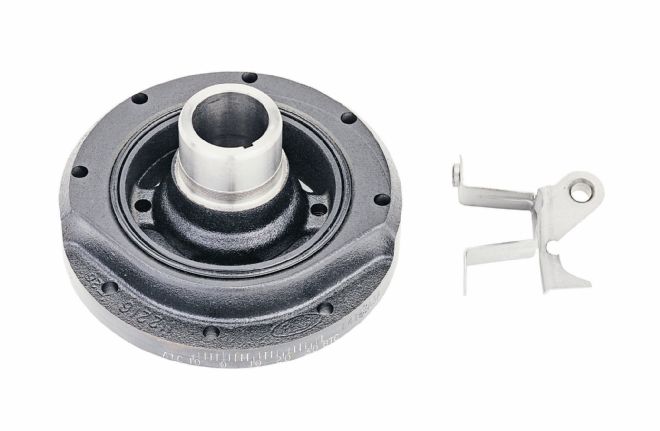
Q:
I’m building a 331ci stroker based on a Ford 302 short-block from DSS Racing. The paperwork that came with the short-block said the engine was internally balanced to 28.2 oz-in. I know the Ford 302 imbalance is 50 oz-in and the Ford 351 is 28.2 oz-in, so why is my 302-based stroker balanced to 28.2 oz-in? Should I get a zero-balanced flywheel and harmonic balancer or use the 28.2 oz-in flywheel and harmonic balancer from the 351?
Thomas Fedorka
Via email
I am working with a 1978 Mustang 302 (small-diameter flexplate). I had a local machine shop rebalance the 1978 flexplate for a 1985 302 engine that I want to use so it matches the changed flexplate balance weight Ford switched to. Anyway, either it was balanced incorrectly or something, but it now vibrates a lot. If I take the crank out of the 1978 with the stock vibration dampener and flexplate in place (I fortunately have an untouched spare), and install it in the 1985 as is, I am of the opinion it will run smooth. Am I correct?
Milton Fogg
San Diego, CA
A:
On an externally balanced small-block Ford, both the flywheel/flexplate and the balancer must have the correct amount of imbalance for the particular crankshaft being used. Failure to use a flywheel/flexplate and balancer combination with the correct amount of external imbalance will result in serious engine damage.
 Ford Racing’s SFI 18.1-certified damper PN M-6316-C351 has a 28.2 oz-in bolt-on imbalance weight. Removing the weight allows it to also work with neutral-balanced custom cranks. Additional universal features include both passenger-side 11 o’clock and driver-side 2 o’clock timing marks.
Ford Racing’s SFI 18.1-certified damper PN M-6316-C351 has a 28.2 oz-in bolt-on imbalance weight. Removing the weight allows it to also work with neutral-balanced custom cranks. Additional universal features include both passenger-side 11 o’clock and driver-side 2 o’clock timing marks.
Prior to 1981, production 302s used a 28.2 oz-in imbalance factor. The 1981-and-later production 302 engines, the current Ford Racing 302-based crate engines, and all the late, unlamented 255ci engines have lightweight cranks that require the 50 oz-in imbalance factor. (Caution: There are reports that some rebuilt, remanufactured “service-replacement” 302 engines intended for 1980-and-earlier models—even some sold through Ford Service—were rebuilt using lightweight cranks, which would require a 50 oz-in flywheel and damper.)
The majority of aftermarket performance stroker cranks are set up for the 28.2 oz-in imbalance factor or (on the high end) may be fully internally balanced. Generally, hot rodders prefer less (or none at all) external balance, believing this may enhance high-rpm durability. The downside is that a fully neutral-balanced, increased-stroke crankshaft may require adding expensive Mallory heavy-metal slugs to achieve proper balance.
 This is the 50 oz-in imbalance version (PN M-6316-A50) of Ford Racing’s SFI-certified balancer. Shown here looking at its backside, you can clearly see the bolt-on weight. These nonproduction balancers may require different thickness spacers (also available through Ford Racing) to properly align with existing production front accessory-drive pulley systems.
This is the 50 oz-in imbalance version (PN M-6316-A50) of Ford Racing’s SFI-certified balancer. Shown here looking at its backside, you can clearly see the bolt-on weight. These nonproduction balancers may require different thickness spacers (also available through Ford Racing) to properly align with existing production front accessory-drive pulley systems.
Thomas, considering your situation first, what the paperwork means is that your nonstock aftermarket stroker crank was balanced for a flywheel/harmonic balancer combination with a 28.2 oz-in external imbalance. In other words, don’t use a neutral-balance flywheel/balancer combo or one with the “wrong” 50 oz-in imbalance with your rotating assembly.
For a 28.2 oz-in imbalance application, in theory one can use any 221, 260, 289, 351C, 351W, or 1968–1980 302 flywheel or flexplate (but not one intended for a production 1981–2001 302). That’s “in theory” because there were 148- (extremely rare, like the flexplate used on Milton’s 1978 Mustang II 302), 157-, and 164-tooth units available. The flywheel/flexplate, bellhousing, and starter nose must be a matched combination. Additionally, a manual-trans flywheel must have the correct bolt pattern for your style of clutch, while an auto trans flexplate must have the correct torque-converter bolt pattern.
Thomas, you’ll also need a 28.2-oz-in–style harmonic balancer. A 351-Cleveland unit won’t work, but one intended for a 302 or 351 Windsor will. However, there are different diameters, thicknesses, timing-mark locations, and crank-pulley bolt patterns—so besides having the right imbalance amount, the damper must also align with your car’s front-end accessory drive system, water-pump nose offset, front-cover setup, and timing tab.
When swapping balancers in a non-OE combination, it is recommended that you accurately locate top dead center (TDC) for the No. 1 cylinder and ensure that the timing tab aligns with the balancer’s “0” mark at that point. For an engine with the cylinder heads on, you’ll need a TDC piston-stop tool that screws into the No. 1 cylinder’s 14mm spark-plug hole (such as Comp Cams PN 4792 or Powerhouse Products PN POW101330). Remove all the plugs and rotate the engine gently by hand using a breaker bar on the crankshaft balancer bolt until you feel the No. 1 piston bump up against the stop. Mark the harmonic balancer in line with the timing pointer. Rotate the engine in the opposite direction until the No. 1 piston again contacts the stop. Make a second mark in line with the timing tab. Using a flexible measuring tape (borrow one from a sewing kit), measure the distance between the two marks and divide by two to find the halfway point between the two marks you made. That point should correspond to the existing “0” mark on the balancer, and the “0” mark should in turn align with the timing pointer. If it doesn’t, modify the existing timing tab or fabricate an expedient tab that’s correctly aligned.
 Even though in production they were used with serpentine drives, AEW’s Mark Sanchez reports most 1981–1995 stock 5.0L/302 dampers with a 50 oz-in balance factor properly align with Mustang II V-belt drives. The 3.950-inch-ol, 50 oz-in, E4TZ-A production damper and its corresponding F1TZ-A timing pointer is available from Ford Racing as a kit (PN M-6316-M50).
Even though in production they were used with serpentine drives, AEW’s Mark Sanchez reports most 1981–1995 stock 5.0L/302 dampers with a 50 oz-in balance factor properly align with Mustang II V-belt drives. The 3.950-inch-ol, 50 oz-in, E4TZ-A production damper and its corresponding F1TZ-A timing pointer is available from Ford Racing as a kit (PN M-6316-M50).
Milton, bearing in mind all of the above, in your case, the problem is that you still are using the original harmonic balancer with its 28.2 oz-in imbalance factor on your new lightweight crank. Install a 50 oz-in imbalance-factor unit and you should be good to go.
In any event, your plan to install the earlier 28.2 oz-in imbalance-factor crank with its corresponding flexplate and balancer is not only way too much work, it probably won’t eliminate the vibration. The reason is that even an externally balanced crank is balanced for the rods and pistons used in the specific engine build—it’s just the externally balanced flywheel/flexplate and harmonic balancer are part of the total balancing factor, as opposed to a crank that’s fully internally balanced with no need for any additional weight on the flywheel/flexplate and balancer. On an externally balanced setup, the amount of external imbalance is a constant, and weight must still be added or subtracted from the crank as needed to achieve a fully balanced condition.
Unless the crank, pistons, piston pins, piston rings, connecting rods, and crankshaft are completely stock from the same application, there’s a good chance that an out-of-balance condition (and hence, vibration) will still exist—after all, in your case, you would end up using an earlier crank with later pistons and rods from a different model year. If the car was just a daily driver (not used for high performance), in theory a bad piston, rod, or crank could be replaced with an identical brand-new Ford service part intended for that same application without the need to rebalance—but I wouldn’t do that for anything beyond a grocery-getter.
Small-Block Ford Imbalance Specs Engine U.S. Model Years Imbalance 221 1962–1963 28.2 oz-in 255 1979–1982 50 oz-in 260 1962–1964 28.2 oz-in 289 1963–1968 28.2 oz-in 302 1968–1980 28.2 oz-in Boss 302 1969-1970 28.2 oz-in 302 1981–2001 50 oz-in 351W (Windsor) 1969–1997 28.2 oz-in 351C (Cleveland) 1970–1974 28.2 oz-in